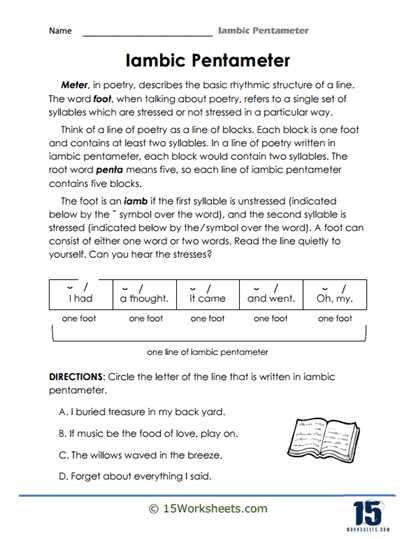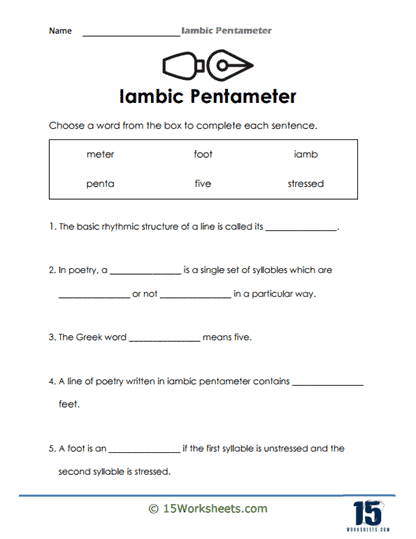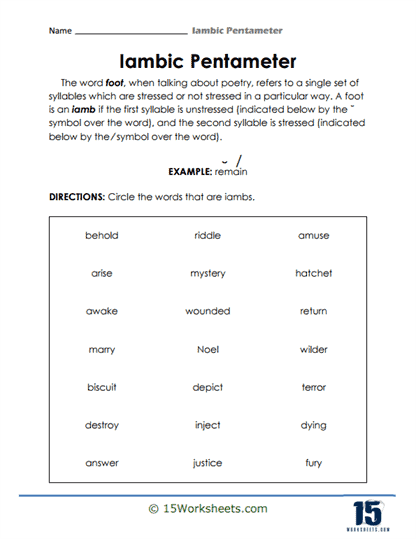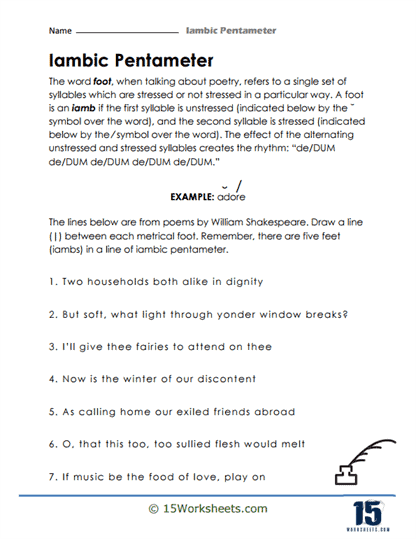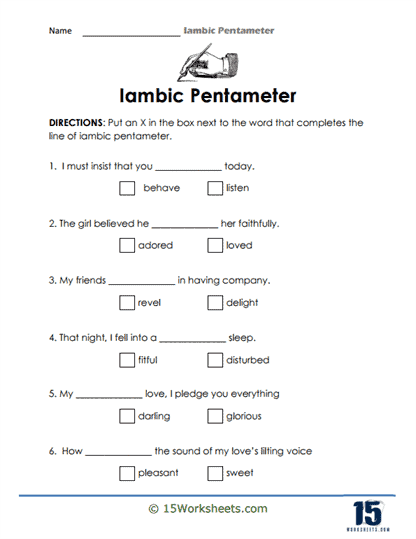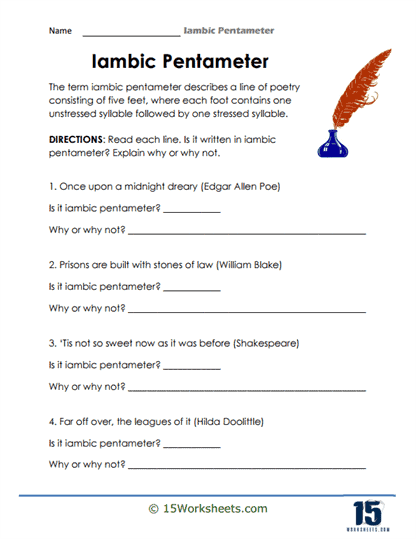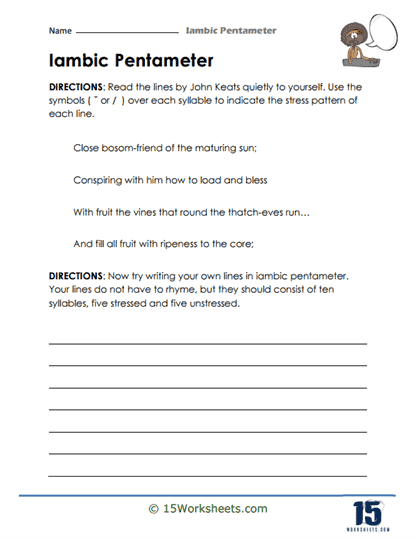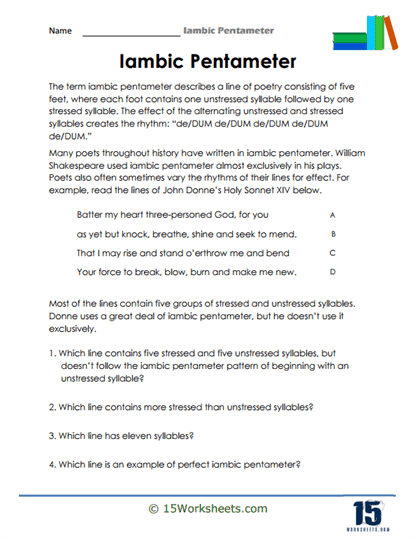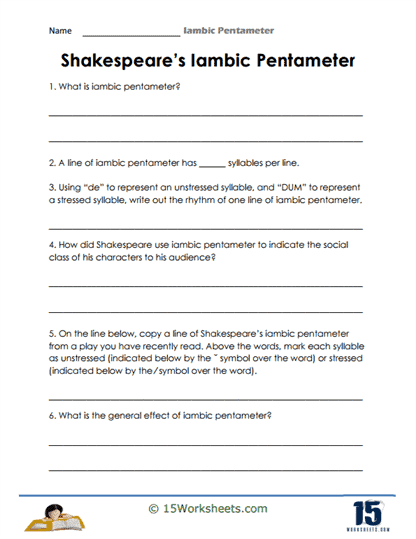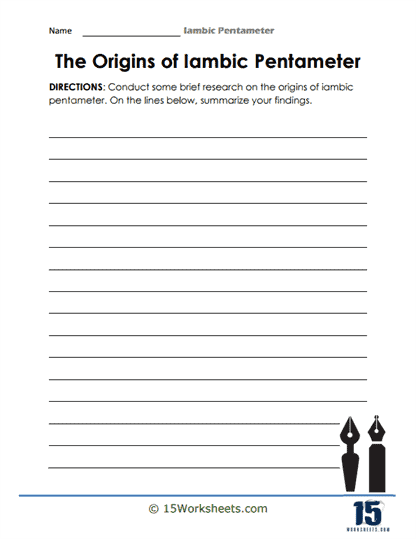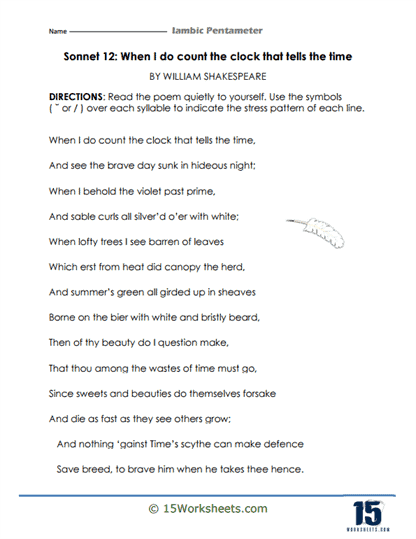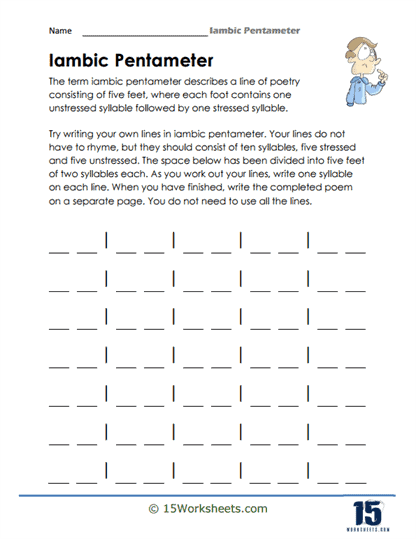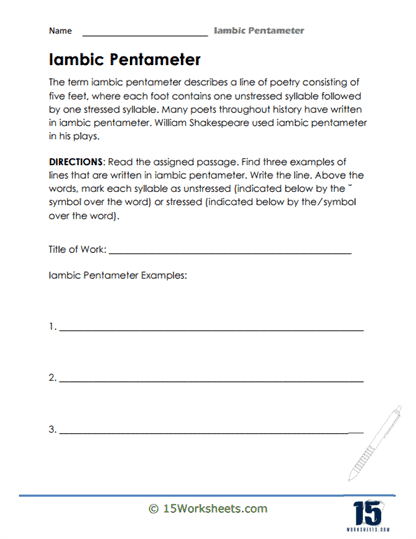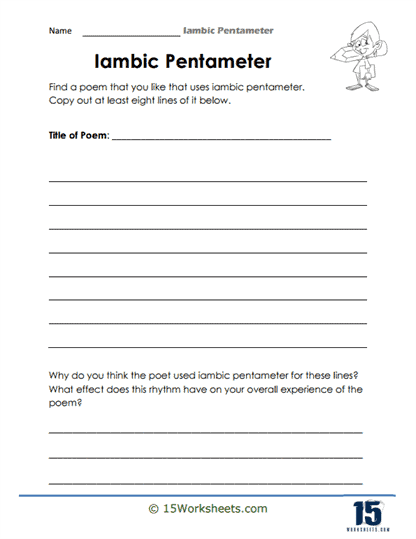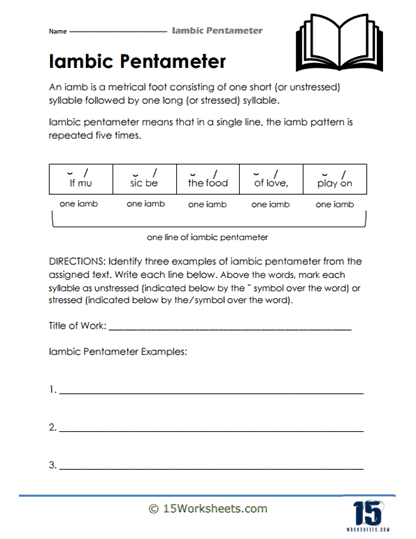Iambic Pentameter Worksheets
All About These 15 Worksheets
Iambic pentameter, a poetic meter consisting of ten syllables per line, alternating between unstressed and stressed syllables, has been a hallmark of English poetry for centuries. Understanding iambic pentameter is not only crucial for appreciating and analyzing poetry but also for developing strong reading, writing, and literary analysis skills.
This collection of 15 worksheets is designed to introduce students to the world of iambic pentameter, helping them understand its importance, recognize its usage in poetry, and apply it effectively in their own creative writing and literary exploration.
What Are Iambic Pentameter Worksheets?
These worksheets will help students understand and practice using the meter known as “iambic pentameter.” This is a rhythm or pattern used in poetry and drama that has a very specific structure.
“Iambic pentameter” is a term that describes a particular type of rhythm or meter that consists of five “iambs” per line. An “iamb” is a unit of poetic meter, or a “foot,” that contains two syllables. The first syllable is unstressed, and the second syllable is stressed, creating a “da-DUM” rhythm. So, a line of iambic pentameter sounds like this – “da-DUM da-DUM da-DUM da-DUM da-DUM.”
On iambic pentameter worksheets, you might find a variety of exercises designed to help students understand and create their own lines of iambic pentameter. Here are some types of exercises you may see:
Understanding the Format – These exercises would likely start with an explanation of what iambic pentameter is, with examples of lines written in this meter.
Identification and Analysis – Some exercises might give students lines of poetry and ask them to identify which ones are written in iambic pentameter. Some exercises might provide students with a poem written in iambic pentameter and ask them to analyze how the rhythm contributes to the meaning of the poem.
Writing in Iambic Pentameter – More advanced exercises might ask students to write their own lines or even entire poems in iambic pentameter.
Understanding iambic pentameter can be a valuable tool for both analyzing and writing poetry. It can also help students better appreciate and understand the works of playwrights like Shakespeare, who frequently used iambic pentameter in their plays. By practicing with iambic pentameter worksheets, students can gain a better understanding of this important literary concept.
What is the Literary Device of Iambic Pentameter?
Iambic pentameter is one of the most commonly used metrical patterns in traditional English poetry and verse drama. The term describes a particular rhythm that the words establish in each line. That rhythm is measured in small groups of syllables; these small groups of syllables are called “feet”. The word “iambic” describes the type of foot that is used (consisting of one unstressed syllable followed by one stressed syllable). The word “pentameter” indicates that a line has five of these “iambs”.
Defining Feature of Iambic Pentameter
The defining feature of iambic pentameter is its structure, which consists of five iambs (da-DUM) per line, or ten syllables in total per line. The rhythm can be understood as five pairs of syllables, each pair containing a soft (or unstressed) syllable followed by a loud (or stressed) syllable. It’s a meter that comes quite naturally to English and closely resembles the rhythm of everyday conversation, which makes it an appealing choice for poets and playwrights.
Examples of Iambic Pentameter in Literature
“Shall I compare thee to a summer’s day?” – William Shakespeare
This line is from Sonnet 18 by William Shakespeare, who is perhaps the best-known user of iambic pentameter. Here, each “da-DUM” iamb is a separate syllable pair – “Shall I / com-PARE / thee TO / a SUM- / mer’s DAY?” This line, like most in the sonnet, follows the iambic pentameter pattern of unstressed/stressed syllables.
“Because I could not stop for Death” – Emily Dickinson
The first line of Dickinson’s famous poem is an example of iambic pentameter. The rhythm can be broken down as – “Be-CAUSE / I COULD / not STOP / for DEATH.” Here, the natural speech rhythm and the iambic pentameter coincide perfectly, which gives the line its quiet, conversational tone. Dickinson often used iambic pentameter, although she also freely varied her meter.
“Do not go gentle into that good night” – Dylan Thomas
The title line from Dylan Thomas’ famous villanelle is a slight variation of iambic pentameter, with an extra syllable at the end. This line has 5 iambs – “Do NOT / go GEN- / tle IN- / to THAT / good NIGHT.” The effect of this line is a sense of forceful, pleading desperation, the rhythm driving forward to the strong stress on the final word, “night.”
In each of these examples, the poet uses iambic pentameter to create a particular rhythmic effect. Shakespeare’s sonnet line is smooth and flowing, creating a tone of calm reflection that suits its theme of eternal love. Dickinson’s line is more conversational, its regular meter mimicking the rhythm of speech to draw the reader into its philosophical musing on death. Thomas’ line uses the driving rhythm of iambic pentameter to highlight its urgent plea against surrendering to death.
Exploring the world of iambic pentameter through this collection of 15 skill-building worksheets offers students an opportunity to develop essential skills in poetry appreciation, analytical thinking, creative writing, literary analysis, and language mastery.
Iambic pentameter is not only a cornerstone of English poetry but also a gateway to understanding the rhythmic and metrical dimensions of language. By engaging with these exercises and activities, students not only enhance their academic abilities but also gain valuable tools for poetic expression, literary exploration, and a deeper appreciation of the beauty and intricacy of language in its poetic form.
The benefits of studying iambic pentameter extend far beyond the classroom, empowering students to be more skillful, expressive, and insightful communicators in both their written and spoken word.

